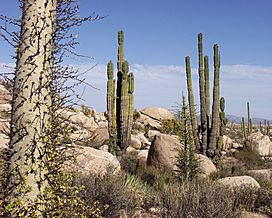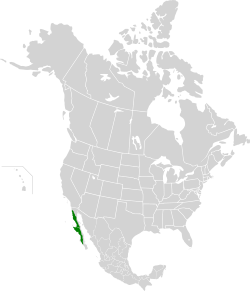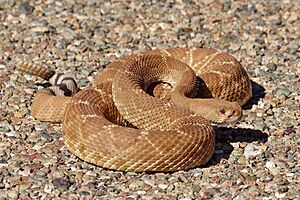Baja California Desert facts for kids
Quick facts for kids Baja California desert |
|
|---|---|

Baja California desert near Cataviña
|
|

Location of the Baja California desert
|
|
| Ecology | |
| Realm | Nearctic |
| Biome | Deserts and xeric shrublands |
| Borders | California coastal sage and chaparral, Gulf of California xeric scrub, Sierra Juárez and San Pedro Mártir pine–oak forests, and Sonoran Desert |
| Geography | |
| Area | 76,296 km2 (29,458 sq mi) |
| Country | Mexico |
| States | Baja California and Baja California Sur |
| Conservation | |
| Conservation status | Relatively stable/intact |
| Global 200 | Yes |
| Protected | 45,940 km2 (60%) |
The Baja California desert (Spanish: desierto de Baja California) is a special desert area, or ecoregion, found in Mexico. It's on the Baja California peninsula. This desert covers most of the western part of the Baja California peninsula. It stretches across much of the Mexican states of Baja California Sur and Baja California. It's a huge area, about 77,700 square kilometers (30,000 square miles). The weather here is dry. But being close to the Pacific Ocean makes it a bit humid and keeps temperatures from getting too extreme. You'll find many xeric shrubs here. Over 500 different kinds of vascular plants grow in this desert.
Contents
Where is the Baja California Desert?
The Baja California desert ecoregion is located on the western side of the Baja California peninsula. It covers most of the Mexican states of Baja California and Baja California Sur. This desert area is about 77,700 square kilometers (30,000 square miles). It includes most of the western slope of the peninsula.
To the west, it meets the Pacific Ocean. To the east, it is bordered by the Peninsular Ranges. The desert stretches from about 31 degrees to 24 degrees north latitude. The land here changes a lot. There are mountain ranges that are 1,000 to 1,500 meters (3,300 to 4,900 feet) high. There are also plains that are 300 to 600 meters (980 to 1,970 feet) high. You can also find large areas of coastal sand dunes.
Neighboring Regions
North of 30 degrees north latitude, the Baja California desert changes into the California coastal sage and chaparral. The higher Peninsular Ranges to the north are home to the Sierra Juárez and San Pedro Mártir pine–oak forests. Here, you can find different tree species, like the California fan palm. To the northeast is the Sonoran Desert. East of the Peninsular Ranges and to the south, you'll find the Gulf of California xeric scrub.
What is the Climate Like?
The climate in the Baja California desert is dry. Most of it is subtropical, meaning it's warm all year. The very southernmost parts are tropical, which are even warmer. Even though it doesn't rain much, the nearby Pacific Ocean helps. It brings some humidity and keeps the temperatures milder. This is different from the Sonoran Desert, which is hotter and drier.
Plants of the Desert
The desert is mostly covered by xeric shrubs. These are plants that can live in very dry places. They grow in different groups depending on how high up they are and what kind of soil is there. The ecoregion has almost 500 different kinds of vascular plants. Many of these plants are endemic, meaning they are found only in this desert.
Some unique endemic plants include:
- The Boojum tree (Fouquieria columnaris)
- The Creeping Devil (Stenocereus eruca)
Animals of the Desert
This desert is home to about 50 different kinds of mammals. Some of the larger mammals you might see include:
- Mule deer (Odocoileus hemionus)
- Desert bighorn sheep (Ovis canadensis nelsoni)
- Puma (Puma concolor)
- The Baja California pronghorn (Antilocapra americana peninsularis), which is very rare and endangered.
Two small mammals are found only in this ecoregion:
- The San Quintin kangaroo rat (Dipodomys gravipes)
- The Baja California rock squirrel (Otospermophilus atricapillus)
Birds of the Desert
About 200 different kinds of birds live in this desert. Some of these include:
- Golden eagle (Aguila chrysaetos)
- Peregrine falcon (Falco peregrinus)
- Crested caracara (Caracara cheriway)
- Osprey (Pandion haliaeutus)
- Burrowing owl (Athene cunicularia)
Millions of ducks and geese spend the winter in the coastal lagoons here. These lagoons include Ojo de Liebre Lagoon, San Ignacio Lagoon, and Magdalena Bay.
Protected Areas
A study in 2017 showed that a large part of this desert is protected. About 45,940 square kilometers (60 percent) of the ecoregion is in protected areas. These special areas help keep the plants and animals safe.
Some important protected areas are:
Both of these protected areas also extend into the nearby Gulf of California xeric scrub ecoregion.
See also
 In Spanish: Desierto de Baja California para niños
In Spanish: Desierto de Baja California para niños
- List of ecoregions in Mexico


